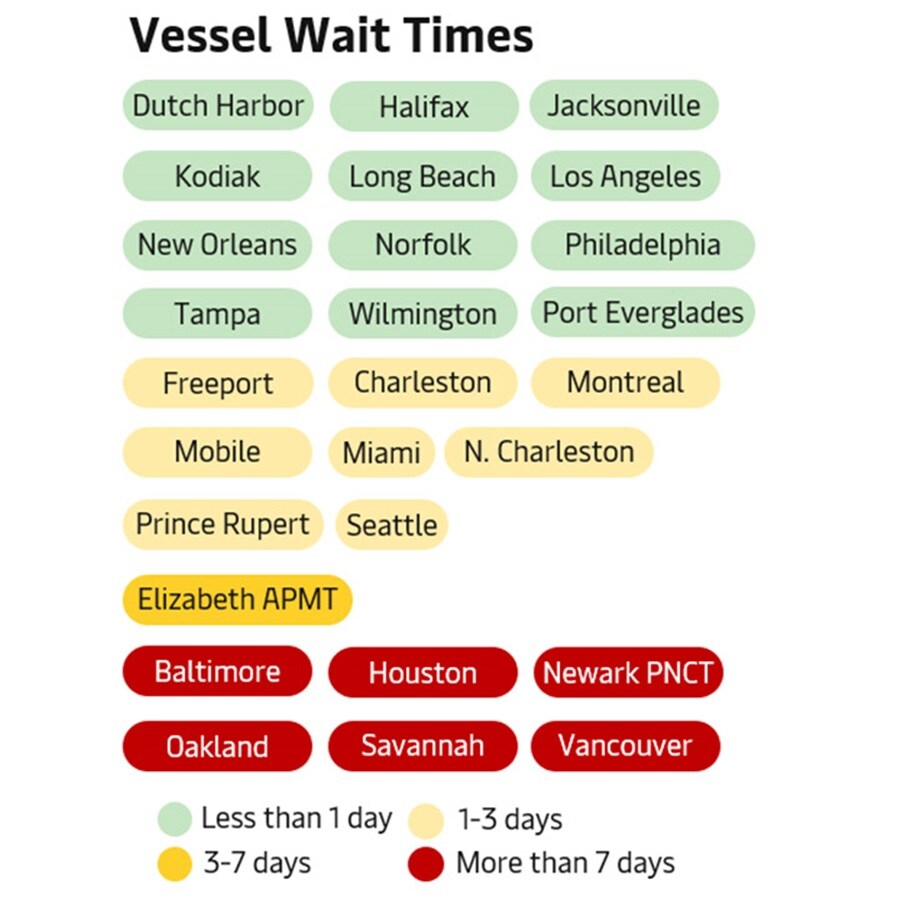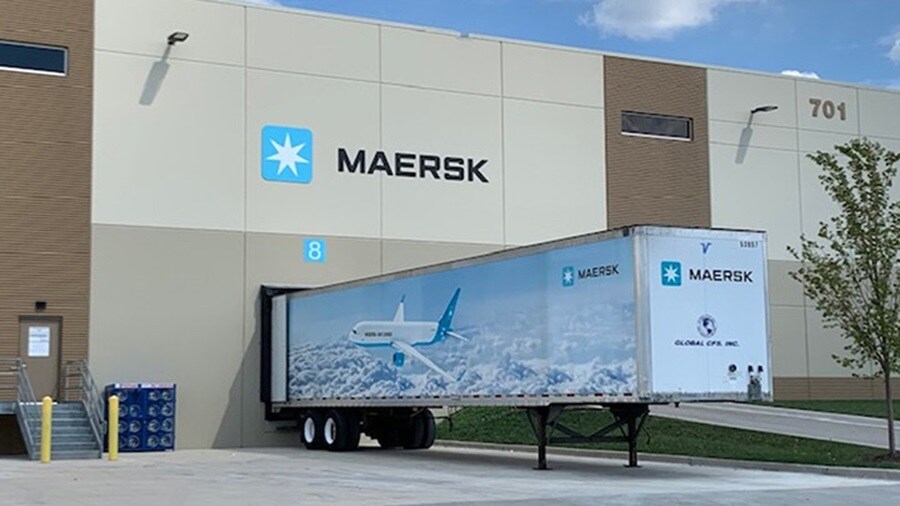Your supply chain’s well-being is our top priority. We at Maersk aim to provide you the most relevant and up-to-date information to help you navigate this period of heightened volatility.
Key Notes on North American Supply Chains
- Tentative railroad worker deal averts strike pending union member ratifications: The terms of the deal run through 2024 and largely mirror a proposal recommended by a Presidential Emergency Board. Membership of just two of the 12 unions have ratified the tentative agreements to date. Members of the International Association of Machinists and Aerospace Workers (IAM) District 19 rejected the deal and continue to negotiate with the National Carrier’s Conference Committee. Union workers have agreed not to strike while the votes are tallied over the next several weeks.
- Strike actions snarl U.K.’s largest ports at Felixstowe and Liverpool: Dockworkers at the Port of Liverpool launched the start of a two-week strike on September 19th. The Liverpool strike will overlap a second strike at Felixstowe scheduled to run September 27th through October 5th. The strikes are expected to cause a ripple effect on schedule reliability in the North European hub ports and impact Transatlantic shipping. Maersk teams are currently reviewing the line-up for the impacted vessels and planning contingencies to mitigate customer impacts. For latest updates on U.K. ports read our Customer Advisory.
- Suez Canal Authority raising toll rates beginning 2023: In a September 17th statement the Suez Canal Authority announced transit fee increases of 15% effective January 1st, citing global inflation and increased energy costs. Analyst viewpoints indicate that, despite the rise in fees, the Suez Canal is still a more cost-effective route than the alternatives and no significant changes to shipping patterns are expected.
Ocean Update
September ocean volumes on our Transpacific and Transatlantic trades are softening, though more elevated than pre-pandemic periods. However, to put industry volume reduction in context, Port of Los Angeles Executive Director Gene Seroka recently stated that even with a slowing second half of the year, “the Port of LA is heading toward the second busiest year” in its history.

Consumer spending patterns have both softened and shifted away from goods-heavy pandemic-era patterns and more towards the services and experiences unavailable during the Covid outbreaks. Warehouse inventories are high and consumer sentiment about future economic prospects are low. Businesses now face the challenging task of adjusting shipping activity and forecasts to match anticipated market demand for the months to come.
Accordingly, we are in the process of actively adjusting our shipping network to align to customer demands. We are optimizing the use of our shipping assets to responsibly manage the business. Network optimization entails improving transit times whenever possible and reviewing the most efficient use of structural blankings for vessel sailings in September and October that result in minimal disruptions to customer supply chains. Notably we are seeing reduced demand during first week of October during China’s “Golden Week” celebration period, which results in significant factory closings. And while reports surfaced about new lockdowns in China due to Covid outbreaks, there have been no notable impacts to our terminal operations or vessel rotations.
West Coast Highlights
Congestion in the Pacific Southwest has improved significantly. Vessel wait times for the Port of Los Angeles and Long Beach have been eliminated. Thirteen ships are within 150 nautical miles of San Pedro Bay, with an additional 43 ships on the way from Asian ports.
We have earmarked two Transpacific routes into Los Angeles as the blankings for Golden Week and we have implemented an ad-hoc upgrade of service to Long Beach to include cargo out of Xiamen. We have also put forward structural blankings on services to Long Beach and Los Angeles to match demand. Through optimization of our schedules, we have reduced transit times on four of our Transpacific services by 14 days or more, putting them more or less on par with pre-covid transits.
There are still large concentrations of long-dwelling containers in Los Angeles and Long Beach. Customers are urged to pick up their containerized cargo as soon as they can to further improve fluidity of the container yards. We continue to actively transfer containers dwelling for nine or more days at the Port of Los Angeles that are customs cleared and have no appointment confirmed for pickup at the terminals.
In the Pacific Northwest, we have seen improvements on transit times into Vancouver, though delays do persist. We are working closely with impacted customers. We continue to work with Centerm in Vancouver to review long-term improvement plans. Improvements have been seen with the opening of Centerm’s Rail Track No. 5 with rail deliveries progressing upwards to improve yard fluidity.
East Coast Highlights
Our network is well positioned to manage current volumes coming into the East Coast. To increase operational efficiency, we are looking to implement structural blankings for services covering Shanghai and Busan into the Eastern U.S. and are actively moving cargo to other services where it would result in an optimized solution.
To improve services to customers, Maersk worked with Newark PNCT to secure a 3-day vessel wait (compared to more than 21-days just a few weeks ago) for customers taking advantage of our Transatlantic westbound services, which bring cargo over from Antwerp, Rotterdam, and Bremerhaven. This compares to other services that may need to wait 1-2 weeks before they can berth at the terminal. Given the shifts in scheduling, we have needed to reset our network on several strings. (See Advisories for TA2- Europe to North America and TA5-Mediterranean to North America.)
We are still experiencing high import container dwell times in Mobile, Newark PNCT and Elizabeth APMT. As always, we are asking customers to arrange for pick up of their cargo as soon as possible. We are practicing the same off-dock drayage program at Newark PNCT in effect for Los Angeles, transferring containers dwelling for 9 or more days to off-site yards.
Savannah continues to experience excessive delays. The Georgia Ports Authority reported its busiest August ever, handling more than 287,000 containers, an increase 18% over the same month last year. Currently there are approximately 30 ships at anchorage, including three Maersk vessels. Wait times range from 12-20 days, though are expected to normalize by November. To mitigate the impacts of the delays into Savannah, we have temporarily adjusted the rotation of our TP10 service from Northeast Asia to stop at Charleston prior to Savannah.
Air Update
New Maersk Air Freight Gateway Operational in Chicago this Fall
The complex air freight market has shown hints of stability over the past month. Airlines had been cancelling and re-routing flights in the wake of staff shortages and fuel costs, but labor is returning to more normal levels after the summer months and we’re seeing a slight reduction in fuel prices after a surge. The reduction of lockdown event frequency in China is expected to boost demand in the coming months, though high inflation and rising interest rates may have a dampening effect.

According to the International Air Transport Association, air cargo is tracking near pre-Covid levels as global demand in Cargo Ton-Kilometers (CTKs) fell 9.7% compared to July 2021. In North America, July cargo volumes were only down 5.7% compared the same period last year. This was an improvement over the 13.5% decline in June. Available Cargo Ton-Kilometers (ACTK) was up 4.2% compared to July 2021.
Maersk is continuing to use its own controlled air freight network to combat industry disruption and keep supply chains moving. Although ocean freight conditions are starting to improve, demand for a reliable alternative for cargo is expected to remain high.
In support of customer demand Maersk is opening a new Air Freight gateway in Chicago this fall. The 60,777 square foot facility is a Bonded Container Freight Station (CFS) that is also a TSA Certified Cargo Screening Facility (CCSF). The operation benefits from access to planeside recovery and direct transfer to the new facility with a dedicated fleet of vehicles. Site staff will be able to provide priority handling and breakdown to make cargo typically available in less than 48-hours from its arrival at Chicago O’Hare International Airport. The site is within an overnight truck drive to 70% of the U.S. population.
See our Maersk Air Freight pages for more information on our air network and expansion.
Topics, Trends & Insights
Be sure to visit our new “Insights” pages where we explore the latest trends in supply chain digitization, decarbonisation, growth, resilience, and integrated logistics.
Economic Headwinds and Supply Chain Disruption Prompt Warehouse Network Reviews

The Federal Reserve approved yet another interest-rate hike on September 21st and signaled more to come in its fight to combat 40-year-high inflation which sits at 8.3%. The rate increases are intended to deliberately curtail investment and spending to slow the economy, cool markets, and push down prices. Most officials also expect unemployment rising to a forecasted 4.4% by the end of 2023 due to the rate increases signal the higher likelihood of a recession. The latest round of difficult economic news comes at a time when warehouse inventories are near historic highs and overall vacancy rates sit at under 3% while supply chain disruptions continue to force business strategy reviews.
Faced with a challenging business environment, import team members, operations personnel, and transportation managers are gathering to conduct warehouse optimization reviews. While warehouse experts review a multitude of factors when analyzing warehouse optimization scenarios three areas standout for consideration:
- Warehouse location(s)
When reviewing complex facility siting decisions, planners can start with the simple question of where they are sourcing their materials and/or final products from and, once ready, whether those products be efficiently shipped to customers when and where needed. Current global conditions have complicated supply side sourcing considerations. For example, some enterprises have seen the reliability of their tier 1, 2 and 3 providers fall in the face of new regulations such as the Uyghur Forced Labor Prevention Act (UFLPA) or geopolitical activity such as the war in Ukraine. Given the business’ strategy, planners need to consider whether a sourcing change is in order and whether the current facility locations are still suitable from a transportation costs perspective. Or, in reviewing the demand side of the equation, has the target customer base shifted in any way that would change facility siting needs in terms of transit times and or costs? Customers happy with 10-day shipping at lower costs can often be served from a different locale compared to customers who expect delivery in 48 hours or less. Who is paying for and managing the outbound freight is also a significant planning factor. A warehouse serving B2C customers might need to be closer to customers due to outbound freight cost and transit time factors versus a warehouse serving wholesale customers that might be closer to the port of entry since the retailer is responsible for moving the outbound freight.
- Warehouse quantities
A number of factors come into play here as you consider your business strategy, market conditions, and operational environment. For example, if your business prioritizes resiliency and is concerned about the possibility of West Coast labor disruptions, you may want to establish a business continuity plan for additional warehouse coverage near alternative gateway locations. Planners also need to consider whether falling consumer demand will result in changes to SKU counts (Stock Keeping Units) requiring a strategy adjustment to meet targeted customer population coverage rates. High SKU counts also make multiple locations difficult given the requirements of paying for and managing multiple inventories replicated across multiple locations.
- Contract/lease obligations and flexibility
If inventories continue to increase as consumer demand softens in the months ahead, planners might find themselves in need of adding short-term contracting options to their mix of agreements to meet current expansion needs. The New York Times reported that consumer spending has slowed to just 0.3 percent in the second quarter and e-commerce sales have drifted down to levels just 3 percentage points above pre-pandemic buying patterns.
If businesses do find themselves in need of a new lease, they need to be prepared for increased real estate costs. According to commercial real estate brokerage firm Newmark, warehouse rents have grown nearly 24 percent over the past two years, reaching $9.56 per square foot in Q2 with some key markets exceeding $15 per square foot. Given existing market rates, some enterprises are actually positioned to sublease their space at a profit to free them up for strategic moves to less expensive markets where real estate, labor, and transportation costs are lower.
Looking out across the 12–18-month horizon, planners need to review their contract and lease obligations and when they have the opportunity to make new arrangements, if needed. As always, looking longer term, planners need to consider scalable options that don’t require a commitment to buy today for a peak they are projecting three years out.
Pros and cons abound when it comes to putting together the best warehouse network for a particular business endeavor. Where real estate prices may rise so may labor, though shipping costs may fall. Each piece of the puzzle affects the others. It’s important to deeply consider all the factors to formulate the questions that need to be answered by your service providers and stakeholders in a timeframe that enables you to act on the big picture.
See our Warehousing and Distribution pages for more information.
Resources and tools to support you
Learn what’s happening in our regions by reading our Maersk Europe, Latin America, and Asia Pacific updates.
Visit us at Maersk.com to handle everything from "Last Free Day" to online payments.
We value your business and welcome your feedback. Should you have any questions on optimizing your cargo flows, please contact your local Maersk professional.
Get in touch
Connect with us with any questions or comments.
无论您需要什么,我们都可以随时为您提供帮助
I agree to receive logistics related news and marketing updates by email, phone, messaging services (e.g. WhatsApp) and other digital platforms, including but not limited to social media (e.g., LinkedIn) from A. P. Moller-Maersk and its affiliated companies (see latest company overview). I understand that I can opt out of such Maersk communications at any time by clicking the unsubscribe link. To see how we use your personal data, please read our Privacy Notification.
By completing this form, you confirm that you agree to the use of your personal data by Maersk as described in our Privacy Notification.

